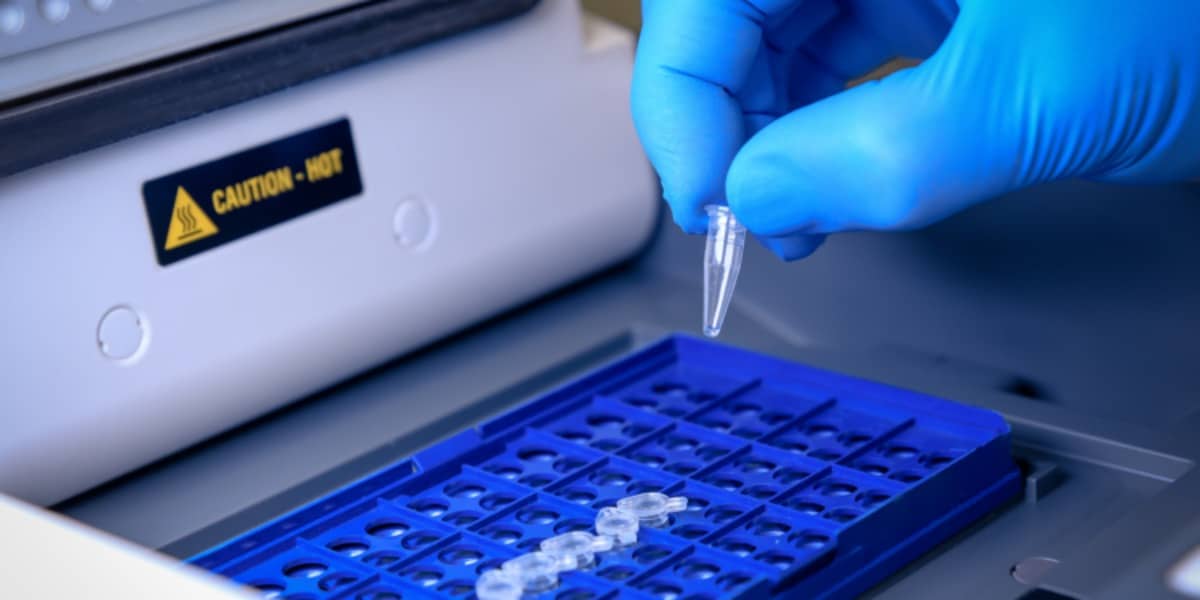It is used to make many copies of DNA. Clinicians and researchers widely use this technique to diagnose the disease. A classic use of PCR is the detection of pathogens, In addition to this, the PCR technique in forensic science to identify criminals. PCR was developed by Karu B. Mulis in 1983, he won the Nobel Prize for Chemistry in the year 1993. Before the development of the PCR process, the alternative processes were time-consuming, expensive and labor-intensive. In PCR you will get many copies of DNA by doing rounds in only a few hours. When the PCR technique was first developed it had problems because DNA polymerase is heat sensitive and DNA polymerase had to refill in every step. Now we used Taq polymerase which led to the invention of the PCR machine. This technique is amplified in many fields. Nowadays identifying fingerprints and DNA is used to solve many crimes which can be possible due to PCR technique.
PCR process:
PCR is a simple enzymatic assay, this process allows you to pick up a DNA sequence of your choice and make many copies of it. PCR is a sensitive assay because to generate copies of DNA you need a small amount of sample. To form a PCR product, the key element is DNA polymerase which links individual nucleotides together. Four bases of nucleotides found in DNA are adenine, thymine, cytosine, and guanine.
Principle of PCR:
The principle of PCR is based on the enzymatic replication of DNA. In PCR, a small part of DNA is amplified using a primer-mediated enzyme. Primer is important because the DNA polymerase can add a nucleotide to the pre-existing 3′- OH group only. DNA polymerase is added to synthesize new strands of DNA complementary to the template DNA. PCR technique is based on a natural process a cell uses to replicate DNA.
Components used in PCR:
PCR constitutes the following components:
- DNA template: It is a sample of DNA, which you want to make copies of.
- DNA Polymerase: For PCR technique taq polymerase is used. It is thermostable and stays stable at very high temperatures.
- Deoxyribonucleotide triphosphate: These are building blocks for the synthesis of DNA and provide energy for polymerization.
- Oligonucleotide polymer: Oligonucleotide polymers are short stretches of DNA.
- Buffer system: Buffer system is important for stability, it provides optimum conditions for DNA denaturation and renaturation.
Types of PCR:
Types of PCR are the following:
1. Real-time PCR ( RT PCR) :
It is a type of polymer chain reaction that detects DNA amplification in real time with the help of fluorescent reporter.
2. Multiplex PCR:
In this type of PCR, amplification of multiple targets in single PCR experiments. It simultaneously amplifies many different DNA sequences.
3. Nested PCR:
It is designed to increase the sensitivity of the process. This process is precise. They reduce the non-specific binding of products.
4. Quantitative PCR:
It used the DNA amplification linearity to detect.
5. Arbitrary primed PCR:
This technique is based on DNA fingerprinting. In this technique, primers are benign used.
Steps involved in PCR:
It is a 3 step process, carried out in repeated cycles
Denaturation:
It is the initial step of PCR. Denaturation of DNA is also called as separation of two DNA strands. During the denaturation steps DNA strands are heated up to 95 Celsius to break the hydrogen bond. Each strand is the template for the new DNA. In this step, strands of DNA are separated into one strand. Applying more temperature ensures the separation of two DNA strands.
Annealing:
Annealing is the second step, in this reaction temperature is lowered to 54- 60 degrees Celsius. This process is carried out for 20- 30 seconds. In this step, primers are bound to their complementary sequences on template DNA. Primers are single-strand sequences of DNA, base length of around 20 – 30. They are the starting point of DNA synthesis. One forward primer and one reverse primer are added for strands to run in opposite directions.
Elongation:
Temperature is raised to 72-80 degrees Celsius. At the 3’ end of the primer bases are added by taq polymerase enzyme. After this step in 5’ to 3’ end DNA is elongated. Taq polymerase can tolerate high temperatures. It added DNA bases to the single strand by attaching it to the primer. The result of this step is obtained as a double-stranded DNA molecule.

These three steps are repeated. In 25- 30 cycles sufficient quantities of DNA can be obtained.
Application of PCR:
PCR has the following applications:
Medicine:
- In gene therapy, monitoring genes.
- Detecting disease.
- Testing genetic mutation in disease.
Forensic science:
- This is used as a tool for genetic fingerprinting.
- Used to identify criminals
- Paternity test.
Research :
- In genomic studies, comparing two organisms.
- It is used for gene mapping.
- It is used to analyse gene expression.
- It is used to analyse DNA and its source such as fossils.
In conclusion, the PCT technique is very cost-effective and has many applications.







